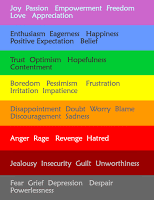 The image above is the Abraham Hicks Emotional Scale. This is a concept put forth by Esther and Jerry Hicks that essentially says that different emotions have different vibrations and the closer we can get to the top of the scale where joy, love, and appreciation reside, the closer we are to being in touch with our true selves and in touch with the source of all energy and love.
The image above is the Abraham Hicks Emotional Scale. This is a concept put forth by Esther and Jerry Hicks that essentially says that different emotions have different vibrations and the closer we can get to the top of the scale where joy, love, and appreciation reside, the closer we are to being in touch with our true selves and in touch with the source of all energy and love.
Tag Archive for: Abraham Hicks
Whether or not you believe in the vibrational scale, we can probably all agree that spending our days in the top two portions of the list looks pretty good. The trick is supposed to be finding ways to jump up one or two “feelings” at a time when you are dealing with a difficult situation. So if you are feeling a lot of fear about a particular incident, you would do well to find some anger about it. If you’re angry, see if there is a way you can simply be frustrated or irritated with it, with the hope of eventually becoming bored with the situation altogether.
One of the things I find most intriguing about this scale is that anger is higher up than fear and despair. As women and girls, we are taught that being angry is generally unacceptable. Guilt is a better alternative to lashing out, as is sadness about something. As a teenager, I actually sought out situations where I could be justifiably angry because it felt so good. When it was clear that I had been wronged and I didn’t need to explain away my rage to anyone, I felt powerful and righteous. Maturing brought me back around to thinking that anger, even if it feels good to me, is not a useful tool and I ought to find less volatile ways to express myself.
Watching my girls argue with such passion on a regular basis, I have come to realize (and point out to them on many annoying occasions) that their disagreements generally focus around two things: power and misunderstandings. Whether or not they’re buying my logic, I don’t know, but it hasn’t seemed to change their behavior much. On Sunday, Eve was particularly cranky and sensitive, crying one moment and railing at the unfairness of her life the next, and Lola was at her wit’s end. As we sat at the dinner table and Eve spat out yet another snarky comment across the table, Lola crumpled into a ball on her chair, hair dangling over one side and toes poking out the other. She gasped and choked and dripped tears on the floor beneath us, her back rising and falling dramatically.
Lola is particularly sensitive to her older sister’s bad moods and Eve knows it. She rolled her eyes and asked to be excused from the table. Bubba and I waved her away, both of us too irritated with her to risk opening our lips to speak. When Bubba had moved into the kitchen to stack the dishes in the sink, Lola scooted over into my lap like a giant tortoise and gradually rose up until her face was right in front of mine.
“You know, I never get angry, Mom. Sometimes it might seem like I am, but underneath I’m really just sad or confused. I don’t think I can remember a time in my life where I was truly mad at anyone. It’s just really sad.” I smelled the milk on her breath and felt my heart stop. This sweet, sensitive, little girl who leads with her heart says the most profound things and sometimes I just don’t know what to do with them.
I hate the thought of encouraging her to turn her sadness into anger, especially if it has to be directed at her sister. I don’t know enough about this model to have a truly enlightened conversation about it, but I think that my discomfort with the anger vibration is that it is outward – directed into the universe. Not that I want Lola to direct it inward. I want her to be happy and joyful, and I truly believe she has a handle on her own feelings, more than most adults I know.
We sat together, holding the weight of her sadness until she could release it. By bedtime she was just slightly melancholy and insisted on giving this message to everyone in the house: “Goodnight, I love you, I’ll see you in the morning.” And with a salute, she went off to her room.
![]()
Thanks for visiting my site. I’m driven by the exploration of human connection and how we can better reconnect to ourselves, our families, and our communities. Aside from my books, I hope you’ll check out my blog, and some of my other writing to find more perspectives and tools.
Let’s Keep in Touch. Join My Email List.
Or email me at: Kari@kariodriscollwriter.com


